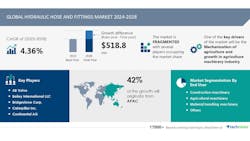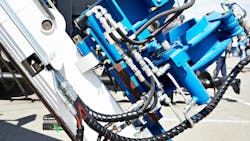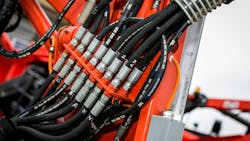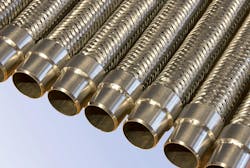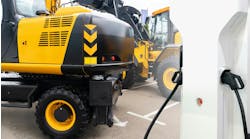Technology research company Technavio is projecting growth in the years ahead for the global hydraulic hose and fittings market. In its new report, “Global hydraulic hose and fittings market 2024-2028,” Technavio is forecasting a compound annual growth rate (CAGR) of 4.36% through 2028.
Hydraulic hoses and fittings are used in a number of applications including construction equipment, agricultural machinery, and aerospace. Market conditions are expected to improve in these and several other sectors starting in 2025 due in part to lowering interest rates and inventory levels which is anticipated to lead to increased demand for machines and their various components once again.
"Economists predict an upturn in 2025 driven by expected interest rate reductions, which are likely to spur demand, particularly in mobile equipment sectors such as construction, agriculture, and forestry machinery," said Laszlo Dobo, Head of Product Management – Hydraulic Solutions, Industrial Solutions Americas, ContiTech. "Additionally, post-election stability is expected to reduce market uncertainties, creating a more favorable environment for capital equipment markets."
These growth projections are in line with those of market research firm Valuates Reports which released a report in 2023 forecasting the global hydraulic fittings market will achieve a CAGR of 5.4% through 2029. It cites demand for hydraulic systems in automotive, construction machinery and manufacturing among the drivers for future market growth.
Technavio’s report points to several factors that will aid growth for hydraulic hoses and fittings including steady demand from customer segments experiencing improved market conditions as well as the need to periodically replace these components due to the harsh environments in which they are often used.
Oil & Gas and Construction Equipment Sectors to be Largest Growth Drivers for Hydraulic Hoses and Fittings
According to Technavio’s report, the oil & gas and construction equipment industries will provide some of the largest growth opportunities for the global hydraulic hoses and fittings market in the coming years.
Both sectors rely on the high pressures provided by hydraulic systems to transmit power for various machine functions, and the hydraulic hoses and fittings used within these systems are key to enabling this.
New Oil & Gas Investments to Benefit Hydraulics
Technavio states in its report that increasing global demand for oil and gas is leading to a rise in drilling projects around the world, which its sees benefiting the hydraulic hoses and fittings market as these components are used in many machines and tools utilized in these projects.
With the continued demand for oil and gas, the research company said there is growing interest in extracting from less conventional sources such as tight oil, shale gas, gas hydrates, coalbed methane, and underground coal gasification. It anticipates these activities will provide significant growth opportunities for the market because of their reliance on hydraulic systems.
Power & Motion has heard from some companies in the fluid power industry that the oil & gas sector will be an important one for them going forward due to the positive market conditions anticipated in the coming years.
Aiding this is the emphasis the new U.S. Presidential Administration is placing on domestic oil and gas production. As reported by Endeavor Business Media partner site Oil & Gas Journal, President Donald Trump signed several executive orders on his first day back in office aimed at increasing oil and gas production in the U.S.
The U.S. Energy Information Administration’s (EIA) Short-Term Energy Outlook released on January 14, 2025, forecasts global oil production and consumption to grow in 2025 and 2026. It also sees growth for U.S. crude oil production over the next 2 years, though potentially at a slower rate in 2026 because of price pressures.
Construction Equipment a Key Market Segment
Technavio is anticipating the largest market share growth for hydraulic hoses and fittings to take place within the construction machinery segment. It notes in its report that in 2018 this segment was the largest, valued at $628.40 million, and is set to maintain this position through 2028, followed by agricultural machinery and material handling machinery, respectively.
Construction equipment encompasses a wide range of machine types — including excavators, wheel loaders, dozers, compactors and more — which rely heavily on the power density provided by hydraulics to get work done. The use cases for these machines are vast, aiding their strong market penetration.
ContiTech's Dobo said large-scale infrastructure projects worldwide are expected to increase demand for hydraulic systems in heavy machinery, including hoses and fittings. Modernization of many of these machines will expand market opportunities as well for the hydraulics sector.
View our content below to learn more about the U.S. Infrastructure Bill passed in 2021 and the benefits such government investment can provide to the fluid power industry.
Residential construction activity in North America, Europe and Asia-Pacific (APAC) is also expected to help the construction machinery segment maintain its higher market share. Technavio notes in its report that large-scale projects in many Asian and Middle Eastern countries focused on housing a growing population will account for a large part of these investments, and thus the need for construction equipment.
In the Association of Equipment Manufacturers (AEM) Q4 report on the construction and agricultural equipment industries, it sees construction growth on the horizon as global inflation slows and interest rates decrease. The infrastructure, energy and utility sectors are those in which it is currently seeing the most growth opportunity due in part to government investments.
AEM states the residential construction sector is lagging; data from the U.S. Census Bureau for December 2024 shows building permits and housing starts were both below the year-ago figures. Interest rates were just lowered at the end of the year, so it will take time for the impact of that to make its way through the market. In addition, mortgage rates remain high and thus could be a factor with which this portion of the construction sector will still have to contend.
Fluctuations in Material Prices Could Present Challenges to Hydraulics Sector
Technavio cites continued fluctuation in raw materials prices as a potential hinderance to the projected growth for the global hydraulic hoses and fittings market. Rubber and steel are the main materials utilized for these components, both of which are susceptible to price fluctuations.
Dobo agrees that price fluctuations for rubber and steel have the potential to impact manufacturing and pricing for hydraulic hose and fitting suppliers like ContiTech. He also noted that tariffs, ongoing geopolitical issues and material shortages may pose risks to production schedules.
The World Bank’s most recent agricultural raw material market outlook, released in November 2024, shows natural rubber prices have increased nearly 40% from the previous year due largely to supply challenges caused by weather conditions. Reduced rainfall in Southeast Asia, where much of the world’s rubber is produced, led to the decline in supply from this region while global demand for natural rubber continued to rise — leading to price increases.
A modest rise of 3% for natural rubber prices over the next 2 years is anticipated by the World Bank although it notes this could be hampered by a slowdown in global automobile production. Therefore, manufacturers of hydraulic hoses and fittings should keep a close eye on rubber prices so they can plan their business expenses accordingly.
After metal prices rose in 2024, the World Bank is projecting a decline in both 2025 and 2026. For steel specifically, Fitch Ratings reports prices fell throughout 2024 and some recovery is anticipated in 2025, though it will vary by region. Steel prices in the U.S. are expected to remain higher compared to other parts of the world because of trade protection measures which have been put in place, such as tariffs.
More tariffs could be on the way as they were among the President’s many campaign promises. At the time of publishing, no tariffs have yet been put in place by the Trump Administration but on his first day back in office the President expressed his desire to enact tariffs on goods imported into the U.S. from a number of countries including the European Union, Canada, and Mexico.
If enacted, this could impact prices for U.S.-based manufacturers reliant on material imports.
"At Continental, we are proactively addressing these challenges by expanding our manufacturing capabilities and introducing advanced technologies," said Dobo. "Our Aguascalientes, Mexico, facility, slated to begin operations in the second half of 2025, will play a key role in ensuring a resilient supply chain and providing customers with cutting-edge solutions that meet evolving market demands."
Despite some of the challenges which may be presented by price fluctuations, steady demand is anticipated for hydraulic hoses and fittings in the coming years as the global economy and various customer markets improve which will aid the market’s future growth.

